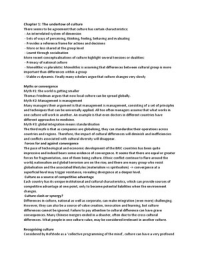Chapter 1: The undertow of culture
There seems to be agreement that culture has certain characteristics:
- An interrelated system of dimension
- Sets of ways of perceiving, thinking, feeling, behaving and evaluating
- Provides a reference frame for actions and decisions
- More or less shared at the group level
- Learnt through socialisation
More recent conceptualisations of culture highlight several tensions or dualities:
- Primacy of national culture
- Monolithic vs pluralistic: Monolithic is assuming that differences between cultural group is more
important than differences within a group
- Stable vs dynamic. Finally many scholars argue that culture changes very slowly
Myths or convergence
Myth #1: the world is getting smaller
Thomas Friedman argues that now local culture can be spread globally.
Myth #2: Management is management
Many managers their argument is that management is management, consisting of a set of principles
and techniques that can be universally applied. All too often managers assume that what works in
one culture will work in another. An example is that even doctors in different countries have
different approaches to medicine.
Myth #3: global integration means standardisation
The third myth is that as companies are globalising, they can standardise their operations across
countries and regions. Therefore, the impact of cultural differences will diminish and inefficiencies
and conflicts associated with cultural diversity will disappear.
Forces for and against convergence
The pace of technological and economic development of the BRIC countries has been quite
impressive and indeed bears some evidence of convergence. It seems that there are equal or greater
forces for fragmentation, one of them being culture. Ethnic conflict continue to flare around the
world; nationalism and global terrorism are on the rise; and there are many group who resist
globalisation and the associated lifestyles (materialism vs spiritualism) convergence at a
superficial level may trigger resistance, revealing divergence at a deeper level.
Culture as a source of competitive advantage
Each country has its unique institutional and cultural characteristics, which can provide sources of
competitive advantage at one point, only to become potential liabilities when the environment
changes.
Culture clash or synergy?
Differences in culture, national as well as corporate, can make integration (even more) challenging.
However, they can also be a source of value creation, innovation and learning, but culture
differences cannot be ignored. Failure to pay attention to cultural difference can have grave
consequences. Many Chinese mergers ended in a disaster, often due to the cross-cultural
differences. What people in one culture value, may be considered irrelevant in another culture.
Recognising culture
Considered by Hofstede as a ‘collective programming of the mind’, culture can have a very profound
,effect on perception, cognition and behaviour without our even being aware of it.
How we see us, how they see us
We only begin to perceive our culture when we are out of it, confronted with another. Culture serves
as a lens through which we perceive the other. The Johari window provides a way of discussing and
‘negotiating’ the different perspectives.
The Johari window tires to shed light on what I know and do not know about myself and what other
know and do not know about me.
Stereotypes: for better or for worse
Stereotyping comes naturally. Stereotypes can be wrong, but they can also be used in a positive way.
The problem with stereotypes is not their existence but the way there are used. Another problem
with stereotyping is that is conjures up an image of stamping the same type on every blank face. It
may be more useful to think of prototypes, which allow for variation around a set of core
characteristics. We must not assume that certain attributes or a culture apply to almost all members
of that culture. Beyond culture:
National identity = how we see us
National image = how we see us
An example is the Swiss, who thought, at the time, others saw them pretty much as how they saw
themselves. However is appeared to be somewhat different.
How we see us and how they see us tells us about them. What we see or do not see can inform us of
our own expectations and experiences, and of what we consider to be important.
, Chapter 2: Discovering culture
The search for meaning
Part of the problem is recognising the impact of culture on management stems from the proliferation
of definitions of culture, and from the tools and equipment used in exploration. Culture has been
defined as ‘shared patterns of behaviour’, but culture is more than behaviour. The same behaviour
can have several meanings and different behaviour can have the same meaning. Moreover, the
underlying assumptions of the behaviour are mostly far from obvious.
Digging deeper
‘Universal problems’ of a group can be resolved in similar or different ways. This culturally general
(etic) perspective allows us to make comparison between cultures. Of these solutions can be
described with regard to a particular group, as culture specific (emic) – requiring us to dig deeper into
the meaning that the group assigns to its practices and even go beyond the groups’ own awareness.
Artefacts and behaviour
There are several examples of artefacts and behaviour within cultures and they can be categories in
the following categories:
Architecture and design
They hint at the underlying assumption regarding internal integration – bringing people together or
keeping them apart, and external adaption – harmonising with or dominating nature. They indicate
the importance of hierarchy, of collective rather than individual effort and the preferred type of
activity and interaction between people.
Greeting rituals
More clues can be found in formalised exchanges such as greeting rituals. The importance of these
rituals should not be overlooked. Cross-cultural differences can also be found in the type of
handshake.
Forms of address
The degree of formality in addressing business relations sends important signals that may not be
intended – anything from respect, to friendliness, to disdain.
Making contact
Another aspect is the amount of physical space considered necessary to be comfortable. As
described by Hall, Northern Europeans and North Americans tend to require a larger personal space
than their Latin European, South-American or Middle Eastern counterparts. In the US there are 4






